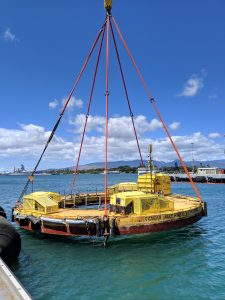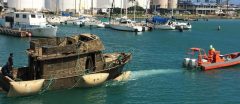Naval Facilities Engineering and Expeditionary Warfare Center (NAVFAC EXWC) in partnership with the University of Hawaiʻi launched its second round of Wave Energy Converter (WEC) testing at the U.S. Navy’s Wave Energy Test Site off Marine Corps Base Hawaiʻi on Oʻahu.
This is the world’s first demonstration of the potentially transformative capability for WECs to enable persistent oceanographic observation and unmanned, undersea vehicle recharge without a cable to shore.
The device uses three power take-off units that convert the motion of the passing waves to electrical power using rotary electrical generators. Control and health-monitoring of these on-board systems are housed in the control center. The WEC is not connected to shore, and the power generated is stored in a battery bank.
Sea Engineering is honored to have been part of this team. We provided logistics, personal, and equipment to install the Fred Olsen Bolt Lifesaver wave energy device and support APL and the University of Washington with their WAMP system. The divers from Sea Engineering connected the device to storm moorings at the 30-meter deep birth, and all three power take-off winch lines to seabed, to allow BOLT Lifesaver to initiate power production.












